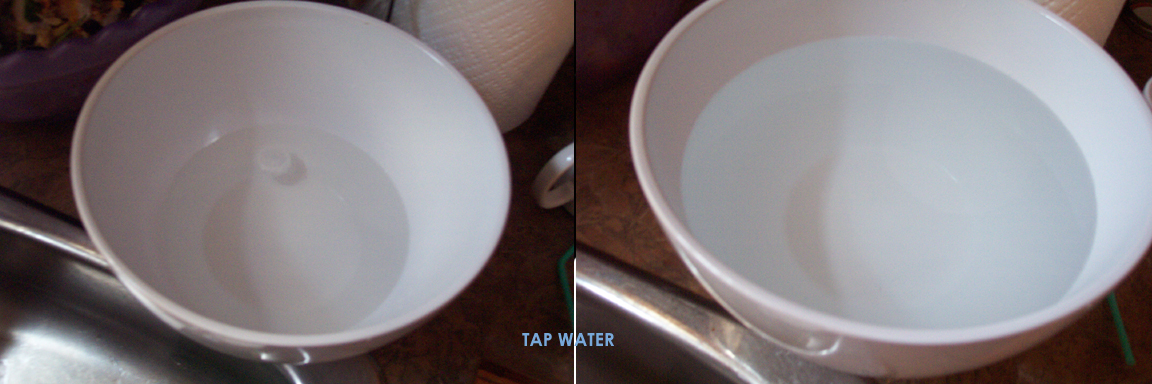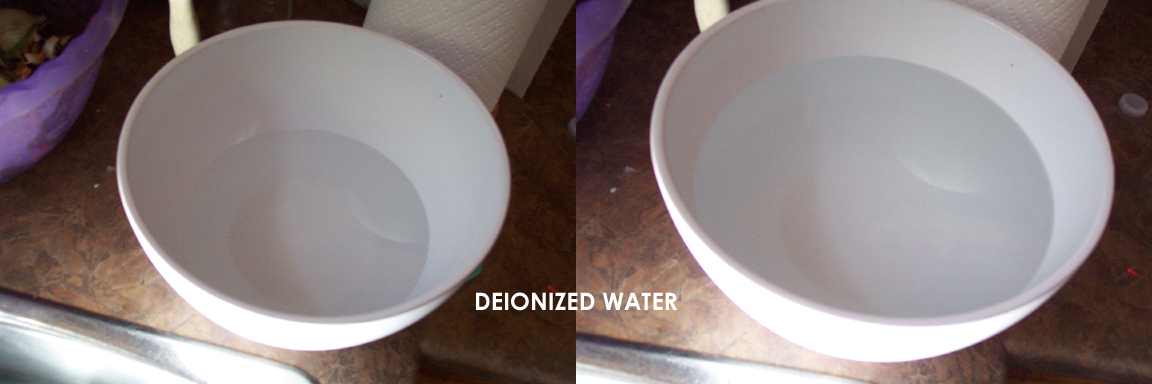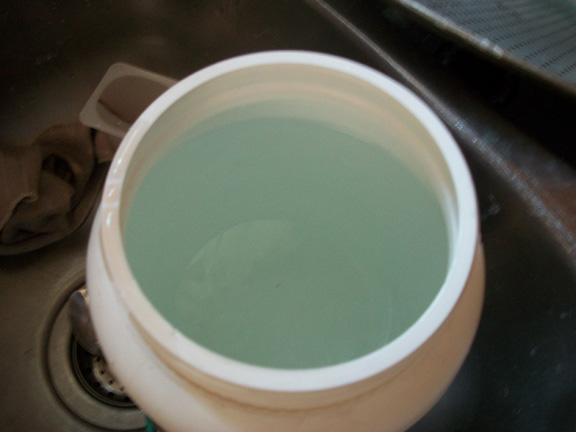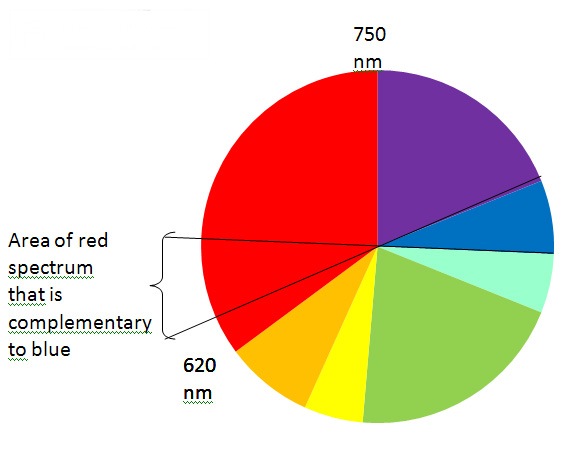If you put a bit of shampoo in your hand, you will notice that it looks a little ligher in color than when it sits in a bottle. This makes us aware that light's path length (as light moves across a transparent object) influences the intensity of color. Could it be that water only appears colorless when there are not enough molecules in light's path to remove some of white light's components?
I like to demonstrate this by simply using a large 8 inch white mixing bowl. If it's only 1/4 filled, the water still appears like it does when coming out of the tap. But when about 3/4 full, a pale blue colour becomes obvious. The bowl's white background helps because light bounces back and forth within it, allowing even more vibrating water molecules to absorb a red portion of the spectrum. Deprived of a bit of red, water in most of its forms consequently transmit a pale blue light.
 One can argue that the tap water I used is not pure. Admittedly, various ions, algae and even suspended silt and mud can definitely introduce all sorts of green and brown hues. If you fill a mixing bowl with deionized water from the lab, which is created by forcing water through an impurity-removing column, the water is still colored.
One can argue that the tap water I used is not pure. Admittedly, various ions, algae and even suspended silt and mud can definitely introduce all sorts of green and brown hues. If you fill a mixing bowl with deionized water from the lab, which is created by forcing water through an impurity-removing column, the water is still colored. Here's another picture that looks less greyish. It was obtained by placing the same deionized water in a narrower but taller white container.
Here's another picture that looks less greyish. It was obtained by placing the same deionized water in a narrower but taller white container. According to the Journal of Chem Ed authors, a better way to demonstrate this is to use a 3 m long by 4 cm diameter length of aluminum tubing with a Plexiglass window epoxied to one end of the tube. I tried it with a 2.5 m by 4 cm plastic pipe, sealed with a glass stopper. When I photographed it with a flash, I did see a beautiful blue color, but my control (a picture of the pipe without the water) appeared just as blue!
According to the Journal of Chem Ed authors, a better way to demonstrate this is to use a 3 m long by 4 cm diameter length of aluminum tubing with a Plexiglass window epoxied to one end of the tube. I tried it with a 2.5 m by 4 cm plastic pipe, sealed with a glass stopper. When I photographed it with a flash, I did see a beautiful blue color, but my control (a picture of the pipe without the water) appeared just as blue!In order to eliminate the scattering of blue light from suspended particles in water, it's not enough to use deionized water. Microfiltration is also necessary. Once that variable is removed, the persistent blue is sure to come from the 3rd overtone of the oxygen-hydrogen stretching vibration of the water molecule.
In fact, the only way that water will leave white light alone is if its hydrogen atoms are replaced with a heavier form called deuterium. The key absorption peak then shifts into the invisible infrared. The following spectra are from the J of Chem Ed reference cited below, and I've pointed out the differences between purified and deuterated water.

| color | wavelength range(nm) |
| violet | 380–450 |
| blue | 450–475 |
| cyanide | 475–495 |
| green | 495–570 |
| yellow | 570–590 |
| orange | 590–620 |
| red | 620–750 |
If you have the artist's color wheel in mind, you may be confused by the absorption of red leading to the transmission of blue. Although red's opposite is green, red's wide range of wavelengths is actually complementary to all hues of green, cyanide and blue. I've drawn a color wheel which is proportional to perceived wavelengths to illustrate this point.
<

Don't feel bad if you were unaware of the color of water. You have company. When Kurt Nassau published his book on colour in 1983, and even a decade later when an excellent article in the Journal of Chemical Education appeared on the subject, the authors pointed out that many scientists were under the illusion that water was intrinsically without color. I looked through my own books and found in The Flying Circus of Physics a completely incorrect explanation for why a lake can seem blue, attributing it mainly to reflections from the surface.
REFERENCES
Charles L. Braun and Sergei N. Smirnov. Why is Water Blue? J. Chem. Edu., 1993, 70(8), 612
Kurt Nassau. The Physics and Chemistry of Color: the 15 Causes of Color. Wiley-Interscience. 1983
http://en.wikipedia.org/wiki/Color_of_water
Jearl Walker. The Flying Circus of Physics. Wiley and Sons. 1977